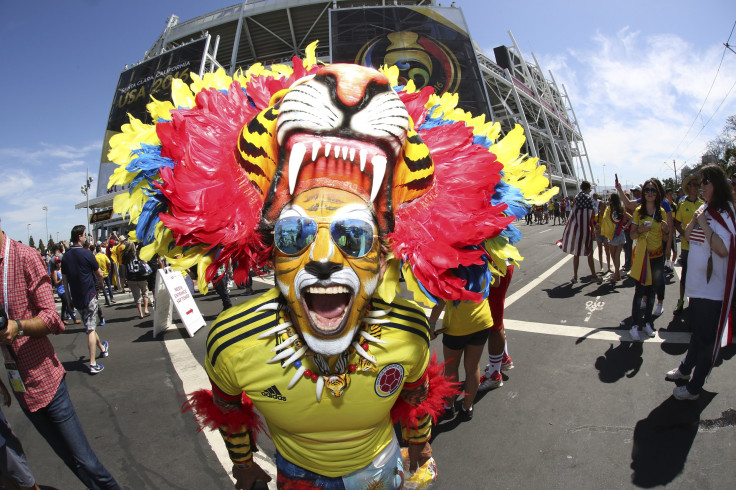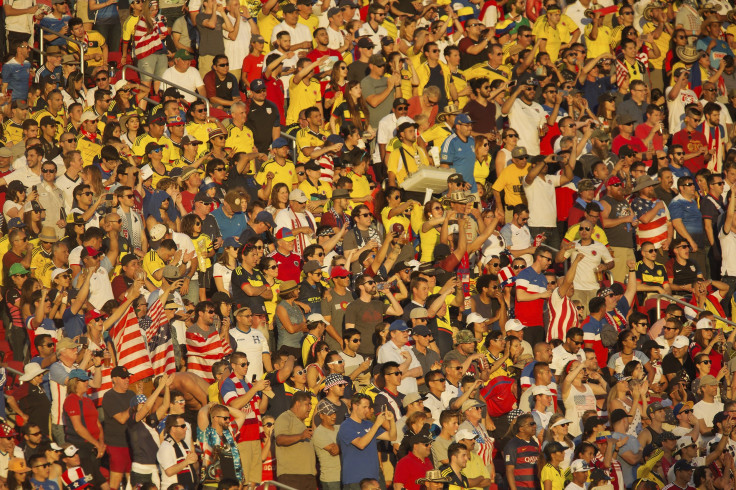Copa America Centenario Offers Unique Soccer Fan Experience

SANTA CLARA, California — In an area of the United States brimming with high-class sporting action this weekend, Santa Clara’s Levi’s Stadium, home of the NFL's San Francisco 49ers, was the scene for a vibrant display of what soccer has to offer. Sandwiched between NBA Finals games hosted by the Golden State Warriors and Stanley Cup Final games at the home of the San Jose Sharks, the biggest soccer event to hit the U.S. in more than two decades kicked off to a wave of color.
Even before the opening game of the Copa America Centenario between the U.S. and Colombia got underway on a balmy Friday evening, it was clear that the event was an international festival. Packing the trains to the stadium from across the Bay Area was a mingling of fans wearing the stars and stripes of the U.S. and the unmistakable yellow, red and blue of Colombia. An intersection not just of color, but of cultures.
Once they finally entered the stadium and took their seats, in a sellout crowd of 67,439, it was apparent that this was a home match for the U.S. in name only. Large swathes of Colombia yellow were seen around the packed stadium — and it was the Colombian fans who would make the most noise for the ensuing 90 minutes.
First-half goals by Cristian Zapata and budding star James Rodríguez gave Colombia a 2-0 win, which was accompanied by dances of delight on the pitch and roars of approval in the stands, including from the most eye-catching Colombian fan, the famed “Birdman.”
Boom in Popularity
It is something the U.S. has had to get used to. Soccer has enjoyed a boom in popularity since 1994, when the U.S. hosted the FIFA World Cup. Two years later, Major League Soccer launched, while the U.S. men’s national team has reached seven consecutive World Cups and the women's team has dominated.
Growing U.S. passion for the game is embodied by a fan group known as the American Outlaws. The most vocal section of U.S. fans at any game, the group now claims to have 40,000 members and 180 chapters across the country. Talking before the game Friday, Drew Farmer, president of the Sacramento, California, chapter, did not have to look far to point to the growth of the game in the U.S.
“This right here, the numbers that you're seeing here, the numbers, the excitement,” he said as thousands of fans filled the stadium around him.
To Farmer, soccer, and supporting the U.S. national teams, both men and women, presents a unique fan experience in a country where the sport still struggles for mainstream attention. Indeed, he believes only college football fans are similarly rabid but, he says proudly, “they’re not as organized as we are.” In the Outlaws, song lyrics, including their famous refrain, “I believe that we will win,” are distributed to all members ahead of the game to ensure they all join the singing.
'Completely Different Culture'
Such organization is not generally shared by their South American guests. As fans lined up to get through the gates, one Colombia supporter originally from Bogota, Michael Ospina, who had made the trip up from San Diego, couldn’t help but notice the variations in the pre-match experience.
“In Colombia everyone’s screaming, it’s a completely different culture and we have different ways of expressing ourselves,” he said. “Here you have to obey by the rules, stay in lines.”

Behind him, a U.S. fan ascribed the delays in getting into the stadium to the joyful unruliness of the Colombians. As another fan in yellow, Derrick Vallejos, who had flown in from New York City for the game, put it about the soccer in his parents’ home continent, “It’s more chaotic, there’s a lot more noise in South America.”
What also makes soccer unique among U.S. sports and makes the country a unique venue for soccer is the melding of different fan groups. Playing the world’s game in by far the world’s biggest immigrant country, home-field advantage for the U.S. tends to be elusive.
It has been a particular issue whenever the U.S. plays Mexico. So for the last four occasions that the U.S. has drawn Mexico for World Cup qualifiers on home soil, it has scheduled the games in Columbus, Ohio, eschewing larger venues in cities with larger numbers of Mexican immigrants.
In the Copa America, where the venues were decided in advance, no such provisions could be taken. Although, speaking after the Colombia clash, U.S. coach Jurgen Klinsmann stressed the positives of the situation.
“That’s hopefully what we see in all the stadiums now going forward — a lot, a lot of fans coming and enjoying the Copa America, a lot of people coming from South America and enjoying the United States as a wonderful host. It's absolutely beautiful to see all the yellow jerseys and all the U.S. jerseys. I hope they enjoyed that evening.”

For the success of the tournament, the mix of fans is undoubtedly a good thing. If soccer fandom in the U.S. can’t yet match the fervor in South America and Europe, then filling U.S. stadiums with fans rooting for other countries can at least help raise the excitement level.
Fans Still Interested
In major tournaments, it is generally seen as a disaster when the host team exits early, as the excitement and fan interest so often leaves with them. Friday's loss to Colombia means the U.S. will have a hard time advancing to the tournament's knockout phase. Yet ticket sales for upcoming matches suggest the impact on attendance won’t be nearly as severe as some may think.
Average prices on secondary ticket market site Rukkus.com show that the U.S. is not the team stirring the most fan interest. Games involving Argentina, featuring the word’s best player, Lionel Messi, and Mexico are both fetching higher prices. On Stubhub, tickets for the match between Argentina and Chile, back at Levi’s Stadium on Monday night, have been in greater demand than those for the opening game between the U.S. and Colombia.

There will be plenty of sell-outs during the tournament, which concludes June 26 with the final at MetLife Stadium, in East Rutherford, New Jersey. But there will also be plenty of empty seats at some matches. Tickets for the contest between Jamaica and Venezuela at Chicago’s Soldier Field have been going for an average price of just $17, well below face value. The nature of a tournament means there was no possibility of arranging the locations of games based on where fan appeal for each team is likely to be highest.
Still, if Friday’s opening game was any indication, the tournament will still be an example of what a major soccer tournament in the United States can offer. And it will be something that the U.S. Soccer Federation hopes FIFA takes note of before choosing a host country for the 2026 World Cup.
It may not always be to the benefit of the U.S. team on the field, but even Outlaw president Farmer welcomes the amalgamation of fans of different countries.
“I think it’s fantastic. All we want to do is grow the sport,” he said. “It really is about the growth of the sport. That’s why our motto is, 'Unite and Strengthen.' And it's not just unite and strengthen the American fans, it’s all soccer fans. And were all one big community that wants to have fun.”
© Copyright IBTimes 2024. All rights reserved.











